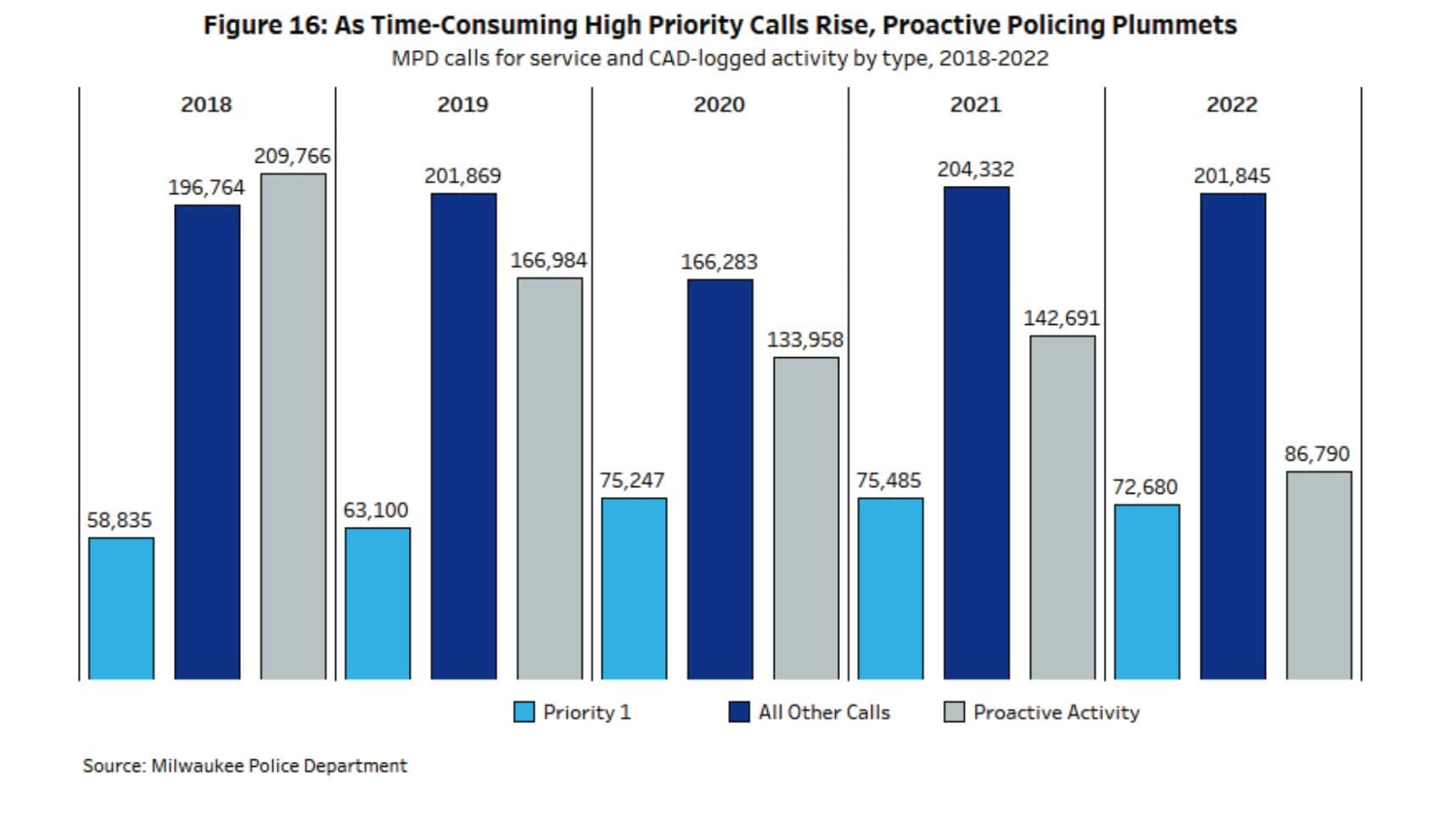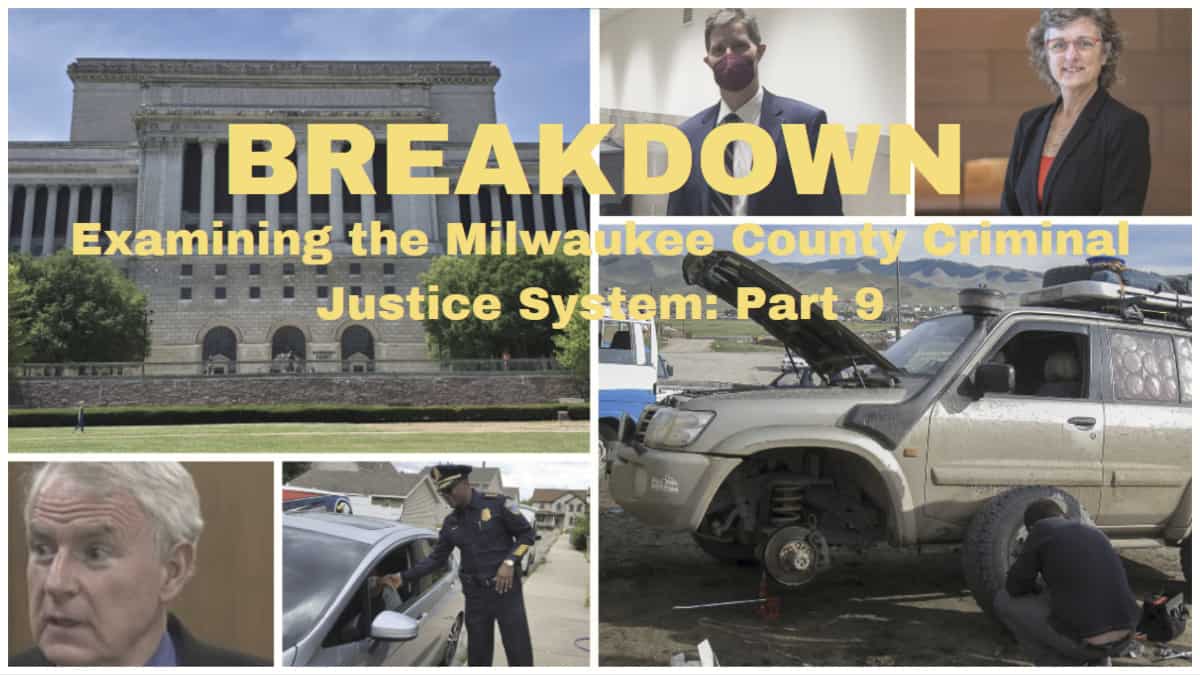PART NINE IN AN 11-PART SERIES.
Milwaukee County’s criminal justice system has broken down at almost all levels.
Although some of the breakdown can be attributed to the pandemic, some can not. Local officials’ questionable policy decisions also play a role, and it’s imperiling public safety. The pandemic exacerbated some already existing trends and caused others, but officials have not developed effective strategies to recover. Some non-pandemic-related issues, like the ACLU-related Collins Agreement’s impact on proactive policing and plummeting numbers of police officers (down 26% since 1996) have been largely overlooked in the media.
PROBLEM #9: The number of medical runs tripled in 2022, exhausting hours of officers’ time as they wait for people to receive care at hospitals. Highest-priority calls rose 24% from 2018 to 2022. Both of these issues stressed officers’ workload. Although dispatched calls for service rose 7% from 2018 to 2022, proactive policing activities declined 59%.

Medical runs are when officers take arrested people to the hospital for treatment or observation. Police officials blame the increase in med runs on jail overcrowding issues, causing arrestees to be held longer at district stations. They blame the jail overcrowding on staff shortages and increases in the time inmates stay in the jail, in part because Tony Evers’ Department of Corrections restricted prison admissions due to COVID-19. The length of stay in the jail was 44% higher in 2022 than before the pandemic.
There are also few Milwaukee police officers, an issue we will explore in part 10.
THE SERIES: We have taken the lead in exploring the problems in Milwaukee County’s Criminal Justice system, breaking stories on Milwaukee police staffing declines (which started years ago), the DA’s high non-prosecution rate and new reliance on summonses, the ACLU Collins Agreement’s deleterious effect on proactive policing, new jail and police policies restricting bookings and arrests, and the massive court backlogs, which leave defendants on the streets longer to re-offend and which provoke constitutional concerns. Milwaukee is at a crisis point, with record homicide numbers and a severe reckless driving crisis.
Now, a new August 2023 report from the Wisconsin Policy Forum has examined Milwaukee County’s Criminal Justice System in great detail, providing fresh data from 2018 (before the pandemic) to 2022. The quotes and data in the opening section come from this report. We are excerpting some of the key statistical findings in a 10-part series to further understanding of the problem. You can’t formulate solutions if you don’t understand the problem’s scope. The few news articles that emerged only superficially skimmed over the report’s findings.
Although the report deals with the context of the pandemic, it also makes it clear that, in many respects, trends imperiling public safety started before it or have continued, even escalating in some cases, in 2022, after its height. In other words, you can’t blame everything on the pandemic. The report also indicates that, in a number of ways, problems that escalated during the pandemic have not been resolved by officials even as late as 2022.
PROBLEM #9
The report authors also interviewed officials to try to dig into why arrests have dropped so much at the police level.
“MPD officials suggest that a likely explanation for the decline in arrests is the increased workload for officers caused by growing
calls for service and increased ‘medical runs’ to transport individuals detained in district stations to hospitals or physicians to attend to their medical needs,” the report says.
“They say increased work volumes in these two areas preclude officers from spending as much time on the types of proactive policing activities that often produce arrests,” it says The report found:
- Data obtained from MPD “verifies both workload increases and the decline in proactive
policing…dispatched calls for service increased by 7% from 2018 to 2022, while proactive policing activities logged by MPD’s dispatch system declined by a whopping 59%.” - “The decline in proactive policing activities began prior to the pandemic, leveled off somewhat at its height, and then declined even more precipitously in 2022.”
- “Also relevant are data showing that the highest-priority calls to dispatchers (i.e. Priority 1 calls), which involve ‘life-threatening conditions’ per MPD, rose 24%, from 58,835 in 2018 to 72,680 in 2022 (after exceeding 75,000 in both 2020 and 2021).”
- “Meanwhile MPD data show that the number of annual medical runs each year hovered between 2,000 and 2,600 from 2018 to 2021 but then almost tripled to 6,638 in 2022. According to officials, these runs can exhaust several hours of officers’ time as they wait with detainees to receive care.”
- “MPD officials attribute the increase in medical runs mainly to an overcrowding situation at the Milwaukee County Criminal Justice Facility (CJF). This situation, according to MPD officials, has caused MPD to hold much greater numbers of individuals at its district stations and for lengthier amounts of times. Consequently, the number of medical runs for detainees at those stations has skyrocketed.”
- “The overcrowding status at the CJF has been attributed both to correction officer shortages and increased lengths of stay. Those increased stays, in turn, resulted at least in part from restricted admissions by the Wisconsin Department of Corrections during the height of the pandemic.”
- Data “from the Milwaukee County Sheriff’s office show that indeed, the average length of stay for a pretrial detainee at the CJF of 183 days in December 2022 was 44.9% higher than it was just prior to the pandemic in February 2020.”


![Mandela Barnes Said ‘Reducing Prison Populations is Now Sexy’ [VIDEO] Reducing Prison Populations is Now Sexy](https://www.wisconsinrightnow.com/wp-content/uploads/2022/09/Collage-Maker-14-Sep-2022-11.44-AM-265x198.jpg)







![Author Exposes the Tragic Realities of the 2020 Riots & the ‘Gaslighting of America’ [REVIEW] julio roses](https://www.wisconsinrightnow.com/wp-content/uploads/2025/11/MixCollage-21-Nov-2025-02-08-PM-8145-265x198.jpg)

